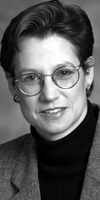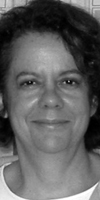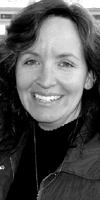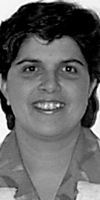
DJC.COM
October 12, 2006
CREW Roundtable
As interviewed by Barbara Travers
|
Ada M. Healey is vice president of real estate for Vulcan Inc. She leads Vulcan’s real estate division and oversees its diverse and active development portfolio, which includes approximately 100 acres of land, the majority of which is located in the Pacific Northwest.
|

|
Five CREW Seattle members joined us for a roundtable recently to share some personal insight into their careers in commercial real estate. All are preeminent leaders in their respective fields.
Q: What motivated you to enter the commercial real estate field and what motivates you to stay?
TAYLOR: What continually motivates me in the field of architecture is my love and passion for what I do.
A teacher suggested architecture when I told him that I wanted my degree in interior design. Touring my first school of architecture, it was love at first sight. After receiving my masters’ degree, I worked on large corporate headquarters in New York as a draftsperson. Within a few months, I was asked to be a job captain on the 300,000-square-foot headquarters for Continental Can.
I also teach a class that introduces children to architecture and design and am involved as a mentor in my firm, which is fulfilling as well as motivating.
|
Wilma Warshak is a senior vice president at Colliers International in Tacoma. She has continually been one of Colliers’ top producing industrial brokers in the Northwest. Warshak was a senior project manager with NBBJ prior to joining Colliers. Her education includes a master’s degree in architecture from the University of Washington as well as a bachelor’s degree in business administration from the State University of New York at Binghamton.
|

|
HEALEY: Prior to joining Vulcan Inc. in 2001 to head up the real estate division, I worked for ING Clarion where I held various positions in asset management, acquisitions and portfolio management. I successfully managed a nationwide equity portfolio of office, retail and industrial assets valued in excess of $3 billion on behalf of several of the nation’s largest institutional investors.
I enjoy real estate because it requires knowledge across a variety of disciplines including marketing, financing, project management, construction, etc. I also like it because of its broad investment appeal from institutions, to high net-worth individuals, to single-family home buyers to small businesses. The market is always changing and one needs to be one step ahead of the market to be successful.
BEASON: One summer, I interned for my mother, Jean McCall, who was project manager for a local construction company, and discovered that I wanted to pursue this industry as my career. It offers a constantly changing environment that provides for continuous growth.
|
Dora Taylor is a senior project manager at MulvannyG2 Architecture in Seattle. She received her bachelor’s degree from Mills College and her master’s degree in architecture from the School of Design at North Carolina State University. She is an architectural designer with a focus on commercial interiors.
|

|
WARSHAK: I was an architect. I found that I didn’t enjoy it and wanted something I was thrilled about. This, amazingly, was brokerage. My plan was to do brokerage for a while until I understood how deals were made and then move into development. I found I really loved brokerage, so I stayed. I continue to be excited by the work. I like the autonomy and the creativity.
WUKELIC: The commercial real estate field is fast-paced and comprised of people who want to get things done. I enjoy the environmental aspect of commercial real estate because environmental issues arise often in commercial real estate — especially in the urban settings — and they have to be resolved to keep projects moving forward. I enjoy problem solving and I like to develop solutions that make sense as part of the real estate transaction and development plans.
Q: What changes, good or bad, have you seen over the past 20 years as far as women in the industry have fared?
TAYLOR: When I completed my graduate work, the freshman class in the school of architecture was about 50 percent women. You don’t see close to that percentage in architectural and design firms now. I’m not sure why that is. Some would be attrition due to raising families. And there is still a glass ceiling with many firms.
|
Kris Beason is the director of special projects at Skanska USA Building and is working on several renovation and tenant improvement projects in downtown Seattle, Bellevue and Redmond. She has more than 19 years of experience in the construction industry, including three years as the director of safety and loss control at the Associated General Contractors of Washington.
|

|
In the majority of firms, the greater proportion of principals, vice presidents and CEOs are still men. I am also acutely aware of the fact that I might not be paid equally to my male counterparts. I do as much research as possible about my position and the standard pay range for those responsibilities and ask for the appropriate salary.
There is still a long way to go in terms of equity. On the other hand, when I first got out of school 23 years ago, I worked on a tilt-up construction building for Redi-Mix Concrete in North Carolina. During construction my manager wanted me to see the progress. The general contractor didn’t allow women on his jobsites. I’m not sure what my manager said to the gentleman, but I walked the site with him that day.
There is a long way to go but within the length of my career we have come a long way. I am fortunate to now work within a company where the principals know that all people are of value and that diverse firms will fare far better in a global marketplace.
HEALEY: I think women are far more likely to help each other now than they were say 10 years ago, as the real estate industry becomes more of a meritocracy and more women are accepted into the industry.
BEASON: Twenty-five years ago, my mother was the first woman assigned to a field position at the construction company she worked for. There were very few women who were pursuing full-time careers, much less in a male-dominated industry. Today, the Pacific Northwest region is a leader in employing women in project management, engineering and administration positions in the construction industry.
|
Julie Wukelic is a principal at Hart Crowser in Seattle. She is an environmental engineer with more than 20 years of experience with Hart Crowser and has dedicated the majority of her career to environmental due diligence and remediation of brownfields in the Pacific Northwest, specializing in urban redevelopment.
|

|
WARSHAK: I don’t think, at least from a brokerage perspective, that there has been much change. Even though women have obstacles, I think you could be as successful 20 years ago as you can be now. It’s no better or worse.
WUKELIC: From the good side, there are more experienced women in the field so as women it’s nice to be around peers who have been through it, too. Women have proven experience and many success stories that provide credibility to the industry and inspire other women that we can be very successful in this field. As far as bad, I can’t identify anything significant. There are still some glass ceilings out there and “good old boy” networks, but they have been broken down significantly over the past 20 years.
Q:What trends are you seeing for women in the industry? Where do you see women excelling and advancing in the next 20 years?
TAYLOR: In the introductory class to design and architecture that I teach to girls, I see a trend, as they get older, to be more reluctant to participate in the classes. The younger girls are totally absorbed and excited by the subject but something happens as they get into the sixth grade. I understand that this phenomenon happens in school in the subjects of math and science. We must support these girls and help them understand their capabilities and that there is no limit to what they can achieve.
HEALEY: I do wish there were more young women entering the field. I think there is a lot of opportunity for young women who are smart and are willing to work hard. I see women advancing in any area which interests them including construction, engineering, financing, marketing, leasing and development.
BEASON: In the past five years, I have worked on several projects where the majority of the project team, the architects, engineers, owner’s representatives, property managers and the general contractor’s teams were lead by women. I believe that the management side of the business continues to attract many women. One area that needs more attention is in recruiting women to the high-paying jobs in the trades. The actual number of individuals working in the trades has decreased over the last 10 years, giving women the potential to fill these vacant positions and earn above-average wages.
WARSHAK: I think more women are entering the real estate industry; mainly in asset management, property management, law and banking. There are still very few that go into brokerage or development as independents, where they are putting their own capital on the line. Men still vastly dominate those fields.
WUKELIC: I see more women entering the field and becoming successful. I think women are more confident because they have seen positive changes in the industry and strong women role models. Women are very good at multitasking and team building. I see more and more women leading teams and getting things done. I see more and more women in leadership roles within the environmental field and real estate community because they do have good leadership skills.
Q: What makes the Puget Sound market different to work in than any other in the U.S.?
TAYLOR: My experience is that there is more of an enlightened sense of what people are capable of achieving as women and men. Also, there is more of an interest in diversity and a desire on the part of many companies to develop a diverse staff.
HEALEY: The Puget Sound market is blessed with a natural beauty unlike anywhere else on earth. We are also constrained geographically by mountains and water. As real estate developers, we have a duty to protect and enhance our natural resources, which is one of the reasons that this region has become, and will continue to be, a leader in sustainable development. Our abundant natural resources and entrepreneurial spirit also attracts a higher percentage of creative class workers, who expect and demand high-performance buildings that complement 24-hour lifestyles.
BEASON: In the Puget Sound market, contractors are more involved in the early aspects of the project before construction actually begins. The teamwork that is generated through the preconstruction activities provides for an approach that allows more creativity, advanced problem solving and innovative thinking. With the advancement of technology, more work can be processed and completed in a shorter amount of time. The construction project durations in this area are very aggressive compared to other areas of the country.
The contractors in Seattle are leaders in construction safety. They believe that all workers should come home to their families in the same condition as they left for work. I am proud to work for a company who is an industry leader for safety.
WARSHAK: From a work perspective, I used to wish I were based elsewhere. The deals were smaller here and often less challenging than in other parts of the country. This has changed. The transactions are far broader now. With the growth of the ports of Seattle and Tacoma, the tech world, and other associated benefits, the Puget Sound area has become a highly desirable and beneficial place to work.
WUKELIC: Well, I’ve only worked in the Puget Sound market, but from what I know from the past in our other offices (East Coast, California, Denver), the Puget Sound area is more environmental focused. Companies want to do the right thing and are committed to the environment. It’s great to be able to apply practical environmental solutions to commercial real estate and development projects.
Q: Share with us your proudest career accomplishment.
TAYLOR: My proudest moment was when I went out on my own for a year and designed and managed a project for a large architectural firm, designing their new offices in Orange County. I received the Calibre Award from the IIDA of Southern California for that project.
HEALEY: The most gratifying accomplishment of my career has been my tenure at Vulcan, where I have worked hard to build and execute a real estate platform to take the company from being an institutional investor to becoming a multi-product developer with a 40-person staff. In the past four years, my team has successfully delivered more than 1.3 million square feet to the market, has 600,000 square feet under construction and has another 2.3 million square feet in pre-development.
BEASON: My greatest accomplishment has been my simultaneous and successful dedication to my job and my family.
WARSHAK: There have been a number of times where I felt proud and appreciated. Being named Washington State SIOR industrial broker of the year in 1990 (I had only started in 1987). Seeing my business grow, obtaining major accounts and beating out the established competition.
Being Amazon.com’s broker and working with them to create a national/international network starting back in 1998. Anticipating the progression of development towards the south, which resulted in a major developer purchasing land and securing a major build-to-suit before the competition woke up. And being told by someone recently that my talk influenced him to quit his unsatisfying job and take a risk at something else he had thought about but never had the nerve to do.
WUKELIC: One of my proudest moments was when we completed the Mariner Stadium transaction and development in a very short time frame. We were part of a great team that was committed to getting it done and working out solutions. We were able to incorporate our environmental investigation work as well as cleanup work with the due diligence team and contractor. It was a great partnership with private and public entities working together to do what some people believed was impossible.
Other Stories:
- More women are picking commercial real estate careers
- CREW: It’s not just for women
- Reaching out to the community
- Breaking it down — CREW by the numbers
- Girls learn the ropes of commercial real estate
- 5 CREW presidents look at the past, present and future
- Teaching girls how to break the glass ceiling
- What makes a woman a leader?
Copyright ©2009 Seattle Daily Journal and DJC.COM.
Comments? Questions? Contact us.